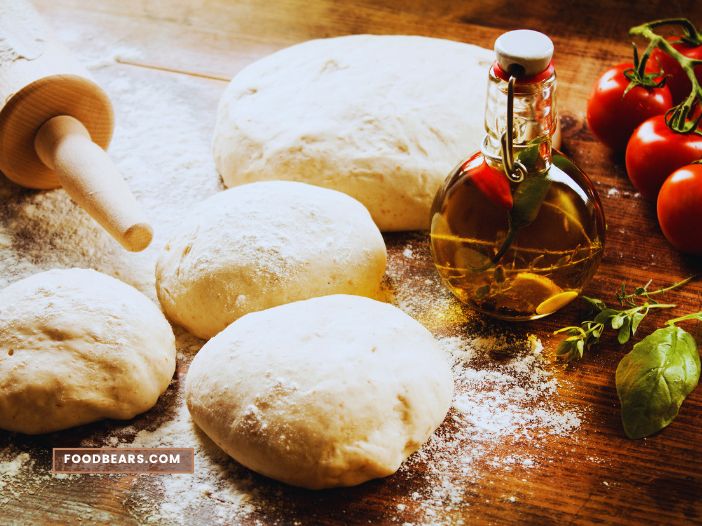To quickly bring your pizza dough to room temperature, cover it in a clean towel and place it in a warm spot in your home. An hour-long process can be expedited to just 30 minutes.
I can’t count the number of times I’ve been hit with an unexpected pizza craving. But then I remember my dough is chilling in the fridge.
Nothing is quite as deflating as waiting for that dough to come to room temperature slowly. I bet you’ve been there too, haven’t you?
Well, those pizza-dough-waiting blues are about to be a thing of the past. Because I’ll share the secrets behind fast-tracking this process and some pitfalls you should avoid. Because when pizza is on the menu, who wants to wait?
Why Does Room Temperature Matter?
Think of pizza dough as a living entity. The yeast within it is alive and hungry for the sugars in the dough. But here’s the kicker. It doesn’t like it too cold or hot. It prefers things just right, typically at room temperature.
When your dough is cold, the yeast is dormant, just hanging out and not doing much. But as the dough warms to room temperature, the yeast wakes up. It starts munching on those sugars, releasing carbon dioxide in the process. The dough expands and becomes soft and pliable. The perfect state for shaping your pizza base.
If the dough gets too warm, the yeast can get overactive and exhaust its food supply. Which might give your dough an off-taste. So, balance your dough at room temperature. It is important for a flavorful, perfectly-textured pizza.
Methods to Bring Pizza Dough to Room Temperature Quickly

All we know about the magic is that room temp works on pizza dough. Now it’s time to address our main conundrum: how to quickly bring that chilled dough to room temperature?
This next section unveils effective methods that expedite this process. From standard kitchen tools to surprising hacks, we have everything covered.
1. Microwave
Surprisingly, your microwave isn’t just for reheating leftovers or making popcorn. It can be a secret weapon in speeding up the process of bringing pizza dough to room temperature.
Here are some full-proof steps to follow:
- Defrost Option: If your dough is frozen, use your microwave’s defrost option. This gentle method slowly raises the temperature without cooking the dough.
- Short Bursts: If your dough is merely chilled, Microwave it on low power for 15-second bursts. Remember, the goal isn’t to cook the dough but to warm it gently.
- Monitor Closely: Keep a close eye on your dough during this process. The microwave can heat unevenly. So pause and rotate the dough to warm on every side.
- Rest Period: After each burst, let the dough rest for a few seconds. This allows the heat to distribute evenly before you go for the next round.
Remember, each microwave varies in power and efficiency. So your times may vary. It’s always better to err on caution and start with shorter bursts.
2. Warm Water
Let’s move away from electronics and get back to the basics. Warm water can be an effective way for your pizza dough to get to room temperature. Here’s how to do it:
- Seal It Up: First, ensure your dough is in a sealed, waterproof bag. This will prevent the dough from absorbing water and becoming soggy.
- Warm, Not Hot: Fill a bowl with warm (not hot!) water. Hot water will cook the dough. So, be cautious.
- Submerge the Dough: Place the sealed bag of dough in the bowl of warm water. This will gently and evenly warm up the dough.
- Change Water if Needed: If the dough is still cold, replace the water with fresh warm water and repeat the process.
Remember, we’re trying to coax the dough back to room temp, not fast-forward it into a pre-baked state. Patience will pay off when the dough rises and makes a perfect crust.
3. Oven
The oven can also help return your frozen pizza dough to room temperature. While it may seem tricky, it’s all about managing the heat delicately. Here’s a guide to using your oven for the job:
- Low-Temperature Setting: Set your oven to the lowest temperature. Preheat and then switch it off. The residual warmth creates an ideal environment for the dough.
- Sealed Container: Place the dough in a sealed container or a covered bowl to prevent it from drying out.
- Short Intervals: Put the container in the oven for 5-10 minutes. Check regularly.
- Rotate and Flip: Rotate and flip the dough occasionally to warm evenly.
Remember, the oven can quickly heat up. So, do not leave the dough unattended. Too much heat can start cooking the dough prematurely.
4. Heating Pad
When you’re thinking out of the box, even a heating pad can become a pizza dough-warming tool. Yes, that’s right. This device, often used for soothing aching muscles, can also aid in reviving your frozen dough. Here’s how you can use a heating pad to achieve pizza perfection:
- Low Setting: Start with your heating pad on a low setting. It will avoid overheating and possibly cooking your dough.
- Dough on Pad: Place your dough (still in its bag or covered bowl) on the heating pad. Ensure it’s not directly in contact to avoid any part of the dough getting too hot.
- Monitor the Process: Keep a close eye on the process. If the dough feels too cold, you can increase the heat setting slightly.
- Flip the Dough: Every so often, flip the dough over to ensure even warming.
A heating pad offers a controlled warmth ideal for defrosting and bringing your dough to room temperature.
5. Warm Rice
Sometimes, the most effective solutions are the most creative ones. Using warm rice to bring your frozen pizza dough to room temperature might sound unusual, but it’s an effective method. It’s all about the gentle, sustained heat that rice can hold and transfer to your dough. Here’s how it works:
- Cook Rice: Start by cooking a pot of rice. It should be warm, not steaming hot.
- Prepare Dough: Protect your dough in a sealed bag or covered bowl.
- Bed of Rice: Once the rice is cooked, lay it out flat and place your covered dough on this warm bed of rice.
- Turn Occasionally: Turn the dough occasionally to make sure the warmth is evenly distributed.
- Cover for Better Results: Cover the dough and rice set up to create a mini steam room for faster results.
6. Room Temperature
We know there are many clever tricks to bring frozen pizza dough back to life quickly. But let’s not overlook the simplest method – suitable old room temperature. It requires no fancy equipment or intricate steps, just time and patience. Here’s the deal:
- Remove from Freezer: Take your dough out of the freezer. It’s time to shine.
- Stay Sealed: Leave the dough ball in its plastic bag or covered bowl. This will keep it from drying out.
- Patience is Key: Place the dough on your kitchen counter and allow the room temperature to do its work. Depending on the dough size and environment, it may take a few hours. It will work faster if you can find a warm place for it.
- Rotate and Flip: Leave it for hours at room temperature and flip it now and then. It will ensure the dough to warm evenly.
- Hassle-free: It is a hassle-free process. It also ensures the dough is not mixed with any other flavors. Though it’s a slow and steady method, it does the job perfectly.
7. Wrap in a Towel and Place it in a Sunny Spot
The sun’s natural warmth is a brilliant way to bring your pizza dough to room temperature. It is an effective method to defrost your dough quickly. Here’s your guide to this sun-powered technique:
- Find the Spot: Find a spot where the sun shines generously. This will be your dough’s warming station.
- Wrap it Up: Wrap your frozen pizza dough in a clean kitchen towel. This will insulate the dough and help retain the sun’s warmth.
- Sunny Siesta: Bring the dough snugly in its towel in the sunny spot. The dough will gradually absorb the warmth.
- Turn it Over now and then to ensure it warms evenly on all sides.
With the sun’s power and patience, your dough will reach room temperature momentarily.
Read more: Pizza Dough with Butter
How Long Does It Take for Pizza Dough to Come to Room Temperature?
The time to bring pizza dough to room temp can vary depending on your dough size. It will also depend on the actual temperature of your room, water, oven, etc. Always monitor your dough to prevent it from overheating or starting to bake.
Here’s a simple table that shows the estimated time it takes for pizza dough to reach room temperature using different methods:
| Method | Estimated Time |
|---|---|
| Room Temperature | 2-3 hours |
| Microwave (Defrost setting) | 1-2 minutes (check every 30 seconds) |
| Warm Water | 30-45 minutes |
| Oven (Lowest setting) | 20-30 minutes |
| Heating Pad (Low setting) | 30-45 minutes |
| Warm Rice | 1-2 hours |
| Wrapped in a Towel in a Sunny Spot | 1-2 hours |
Tips for Handling Pizza Dough
Handling the pizza dough is a crucial step in your pizza-making journey. Not only does it shape the pizza, but it also plays a significant role in its taste and texture. Here are some tips to guide you:
- Warm Up Your Dough: Dough is like a sleepy bear. It must warm up before stretching and moving quickly. Remove your dough from the fridge and leave it at room temperature first. It will be much easier to work with.
- Hands are Best: A rolling pin is like a bulldozer for your dough. It can squash all the air and make your pizza flat. Instead, use your hands to stretch out the dough gently. It keeps all those lovely bubbles that make your crust fluffy and light.
- Rest Time: If your dough keeps snapping back when you try to stretch it, it needs a little break. Let the dough sit for a few minutes, then try again. Just like us, sometimes it needs rest to behave better.
- Just Enough Flour: Flour can stop your dough from sticking to your hands or the table. But be careful. Too much can dry out your dough and make your pizza hard. Just sprinkle a little bit, like dusting powdered sugar on a pancake.
- Avoid Overworking the Dough: Touching your dough too much can make it tough. The less you handle it, the better. Try to be as gentle as possible when you’re shaping your pizza.
- Preheat Your Baking Surface: A preheated pizza stone or baking sheet can create a beautifully crisp crust. It mimics the intense heat of a traditional pizza oven. You need a hot oven for a crispy pizza crust. It’s even better if you preheat your pizza stone or baking sheet. When you put your pizza in, the dough starts cooking immediately, and you get that tremendously crispy bottom.
FAQs
Q. What is the ideal temperature for pizza dough to rise?
The ideal temperature for pizza dough to rise is typically between 75 and 85 degrees F (24-29 degrees C). This is the sweet spot where yeast thrives and converts the sugars in the dough into carbon dioxide gas. This causes the dough to rise.
Q. Can you leave pizza dough to prove for too long?
Yes, it is possible to over-prove pizza dough. If you left to proof for too long, the yeast can consume all the available sugars in the dough. It will produce less carbon dioxide. This can make the dough flat, dense and lacks the desired fluffy texture. Overproved dough may also develop a sour, alcoholic taste.
Q. Should I let refrigerated pizza dough come to room temperature?
Yes. It’s generally a good idea to let refrigerated pizza dough come to room temperature before using it. This is because the fridge’s cold temperature slows the yeast activity.
Q. Can you leave your pizza dough out overnight to rise?
Yes, you can leave your pizza dough out overnight to rise. But it’s best to do this in a cooler environment to slow the yeast activity and prevent over proving. This method is often called a “cold fermentation” or “retardation” process. It is commonly used in bakeries and pizzerias.
Conclusion
So, we’ve journeyed together through the ins and outs of quickly bringing pizza dough to room temperature. It’s a small detail in the grand scheme of pizza perfection. With these handy tips and tricks, you will be ready to tackle this challenge head-on.
So, for the next pizza pinch, remember: patience is all you need to get that dough ready and ready to go.

Ella Foster, co-founder of FoodBears.com, is a skilled writer whose love for cooking fuels her creative work. Her passion for experimenting in the kitchen brings authentic flavor and culinary inspiration to every piece she crafts for the platform.
